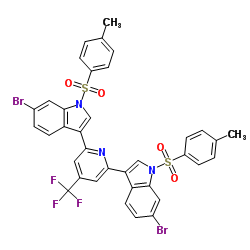Thioredoxin reductase

Thioredoxin reductase structure
|
Common Name | Thioredoxin reductase | ||
|---|---|---|---|---|
| CAS Number | 9074-14-0 | Molecular Weight | 843.527 | |
| Density | 1.6±0.1 g/cm3 | Boiling Point | 912.0±75.0 °C at 760 mmHg | |
| Molecular Formula | C36H24Br2F3N3O4S2 | Melting Point | N/A | |
| MSDS | USA | Flash Point | 505.3±37.1 °C | |
|
Design, synthesis, anti-schistosomal activity and molecular docking of novel 8-hydroxyquinoline-5-sufonyl 1,4-diazepine derivatives.
Bioorg. Chem. 46 , 17-25, (2013) Schistosomiasis remains one of the most prevalent parasitic infections and has significant public health consequences. Praziquantel (PZQ) is the only drug currently administrated to treat this disease. However, praziquantel-resistant parasites have been ident... |
|
|
Compensating for the absence of selenocysteine in high-molecular weight thioredoxin reductases: the electrophilic activation hypothesis.
Biochemistry 53(4) , 664-74, (2014) Mammalian thioredoxin reductase (TR) is a pyridine disulfide oxidoreductase that uses the rare amino acid selenocysteine (Sec) in place of the more commonly used amino acid cysteine (Cys). Selenium is a Janus-faced element because it is both highly nucleophil... |
|
|
Why is mammalian thioredoxin reductase 1 so dependent upon the use of selenium?
Biochemistry 53(3) , 554-65, (2014) Cytosolic thioredoxin reductase 1 (TR1) is the best characterized of the class of high-molecular weight (Mr) thioredoxin reductases (TRs). TR1 is highly dependent upon the rare amino acid selenocysteine (Sec) for the reduction of thioredoxin (Trx) and a host ... |
|
|
Design, synthesis, and biological evaluation of benzoselenazole-stilbene hybrids as multi-target-directed anti-cancer agents.
Eur. J. Med. Chem. 95 , 220-9, (2015) To identify novel multi-target-directed drug candidates for the treatment of cancer, a series of benzoselenazole-stilbene hybrids were synthesised by combining the pharmacophores of resveratrol and ebselen. The biological assay indicated that all of the hybri... |
|
|
Susceptibility of human head and neck cancer cells to combined inhibition of glutathione and thioredoxin metabolism.
PLoS ONE 7(10) , e48175, (2012) Increased glutathione (GSH) and thioredoxin (Trx) metabolism are mechanisms that are widely implicated in resistance of cancer cells to chemotherapy. The current study determined if simultaneous inhibition of GSH and Trx metabolism enhanced cell killing of hu... |
|
|
[Carbohydrate restriction in the larval diet causes oxidative stress in adult insects of Drosophila melanogaster].
Ukr. Biokhim. Zh. 85(5) , 61-72, (2013) The influence of 20 and 1% glucose and fructose, which were components of larval diet, on the level of oxidized proteins and lipids, low molecular mass antioxidant content as well as activities of antioxidant and associated enzymes in adult fruit fly Drosophi... |
|
|
KEAP1-dependent synthetic lethality induced by AKT and TXNRD1 inhibitors in lung cancer.
Cancer Res. 73(17) , 5532-43, (2013) Intrinsic resistance to agents targeting phosphoinositide 3-kinase (PI3K)/AKT pathway is one of the major challenges in cancer treatment with such agents. The objective of this study is to identify the genes or pathways that can be targeted to overcome the re... |
|
|
Entamoeba histolytica: identification of thioredoxin-targeted proteins and analysis of serine acetyltransferase-1 as a prototype example.
Biochem. J. 451(2) , 277-88, (2013) Entamoeba histolytica, the causative agent of amoebiasis, possesses the dithiol-containing redox proteins Trx (thioredoxin) and TrxR (Trx reductase). Both proteins were found to be covalently modified and inactivated by metronidazole, a 5-nitroimidazole drug ... |
|
|
Caveolin-1/PTRF upregulation constitutes a mechanism for mediating p53-induced cellular senescence: implications for evidence-based therapy of delayed wound healing in diabetes.
Am. J. Physiol. Endocrinol. Metab. 305(8) , E951-63, (2013) A heightened state of oxidative stress and senescence of fibroblasts constitute potential therapeutic targets in nonhealing diabetic wounds. Here, we studied the underlying mechanism mediating diabetes-induced cellular senescence using in vitro cultured derma... |
|
|
Simvastatin inhibits the core promoter of the TXNRD1 gene and lowers cellular TrxR activity in HepG2 cells.
Biochem. Biophys. Res. Commun. 430(1) , 90-4, (2013) Thioredoxin reductase 1 (TrxR1) is a selenocysteine-containing redox-active enzyme that is thought to be important during carcinogenesis. We have recently shown that treatment with statins, HMGCoA reductase inhibitors, reduces the levels of TrxR1 in liver of ... |